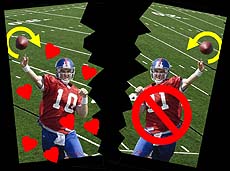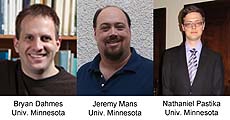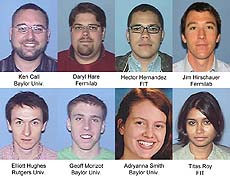An ambidextrous W boson?
 |
| The weak force loves particles that spin in one direction but completely ignores particles that spin the other way. In today's article, I describe a search for a particle that would interact with the ignored spin.
|
Of the four known subatomic forces, the weak force has what seems to be a particularly bizarre behavior. It's a lefty. What exactly does that mean in the subatomic realm? To understand, you need to remember that fundamental particles spin and that they spin in a peculiar way.
Suppose you're playing catch with someone using a football. If you throw the football properly, the ball spins around the long axis of the ball. As you see the ball coming towards you, you see the ball spin in either a clockwise or counterclockwise direction. Scientists call the clockwise rotation left-handed, because if you take your left hand and aim your thumb in the direction the ball is moving (toward you), the fingers of your left hand naturally wrap in the clockwise direction.
The strong and electromagnetic forces, with their gluons and photons, don't care which way the particle is spinning. But the weak force, with its W boson, will interact with only a left-handed particle. W bosons just don't interact with counterclockwise-spinning particles. And, while it seems weird, the theory of the weak force has long accommodated this fact.
On the other hand, given the symmetry of the other forces, maybe the problem is that we just haven't found the kind of W boson that interacts with right-handed particles. This isn't an unreasonable conjecture — maybe the right-handed W bosons are just much heavier than the familiar left-handed versions. If that's the case, then the LHC, with its high-energy beams, would be a perfect place for finding right-handed W bosons.
While symmetry and aesthetic considerations might be enough reason to look for heavy right-handed W bosons, some related theoretical ideas have been proposed. One such thought involves the neutrino, which is the only particle that feels only the weak force. Neutrinos are incredibly light, much lighter than other particles that have mass. Given this discrepancy, maybe the neutrinos don't get their mass from the Higgs boson as other particles do. It could be an entirely different mechanism. Neutrinos are also left-handed particles, and scientists have proposed that perhaps there exists a heavier and right-handed version. Under this theory, the masses of the left-handed and right-handed neutrinos are connected in that if one goes up, the other goes down. This connection is called the seesaw mechanism.
Given the interesting possibilities, CMS searched for the two inextricably linked theoretical particles: heavy, right-handed W bosons and neutrinos. No evidence was found for either, although the new measurement is the most precise one thus far.
—Don Lincoln
 |
| These U.S. scientists contributed to this analysis.
|
 |
| These physicists are involved in testing the QIE chip for the CMS hadron calorimeter upgrade. The QIE chip takes electrical signals from the detector and converts them to numbers so that computers can analyze the data. |
|